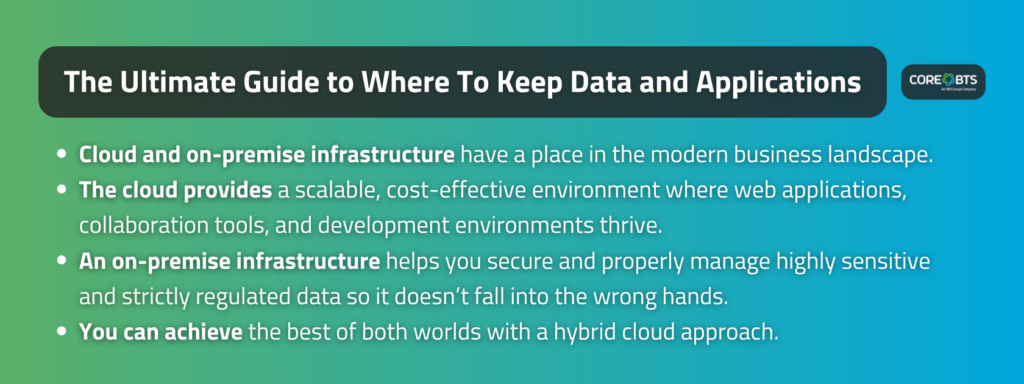Explore where your data and applications should move and why.

The cloud revolution has reshaped how businesses manage data and applications. But let’s face it, it’s not a one-size-fits-all solution.
As an IT executive tasked with making critical decisions regarding your organization’s future, you’ve likely wondered whether to move workloads to the cloud, keep them on-premise, or find a middle ground.
This article guides you through these choices, their pros and cons, and the types of data and applications that thrive in the cloud and on-premise. You’ll also learn about maximizing flexibility and control with a hybrid cloud approach. Let’s jump right in!
Cloud vs. On-Premise Infrastructure
When discussing cloud computing, IT leaders typically differentiate between “public” and “private” cloud environments. A public cloud means leasing computing power and data center resources from a third-party provider on a pay-as-you-go basis. Here, the provider owns, manages, and maintains the infrastructure, and you share these resources with other businesses in a multi-tenant setup.
On the other hand, an on-premise model gives you full ownership and control over your computing and data center resources. This means that all infrastructure is housed, operated, and managed directly within your organization’s physical location.
It’s also possible to create a “private” cloud on-premise by virtualizing compute resources in much the same way public clouds do. The key difference is that, with a private cloud, you manage and control the IT infrastructure yourself, without relying on a third-party provider. This offers greater control and customization, while still providing the flexibility and scalability benefits of cloud computing.
There are some critical factors to consider when choosing cloud or on-premise solutions. These include:
- Budget: How flexible is your budget? Can you make a significant upfront investment, or would you prefer to pay as you go?
- Scalability: What are the organization’s future expansion goals? Does it currently experience variable or fixed, predictable demands for its services? How would you like to manage these?
- Security: What does your security and compliance landscape look like? Do strict regulations govern your industry?
- Control: How much control do you need over data and applications?
Let’s start by breaking down the applications you should move to the cloud.
Applications Ideal for Cloud Migration
Cloud infrastructure is excellent when you’re looking for an easy-to-deploy, cost-effective, and scalable solution. It allows you to get up and running instantly, pay as you go, and increase or reduce capabilities on demand.
That said, it benefits some applications more than others. Those ideal for cloud migration include:
Web Applications And Collaboration Tools
Web applications and collaboration tools are highly effective for managing geographically dispersed teams or hybrid work environments. These cloud-based solutions enable team members to work together in real time from any location with an internet connection, increasing productivity and streamlining communication.
Development And Testing Environments
As you likely know, DevOps, agile methodologies, and other modern development practices require design, prototyping, mash-up, wireframing, code branching, automated development platforms, and test tools for continuous integration.
All these require several code versions and builds, meaning your team must be able to spin up and down multiple database and application servers in parallel. Without virtualization, the servers may occupy one physical server each, resulting in massive underutilization.
Moving these to the cloud makes sense. It accelerates iteration and innovation, reduces network latency and performance issues, and simplifies the lifecycle. Plus, processing and storage resources can be de-allocated once development and testing are complete, meaning you pay only for what your team uses.
While cloud infrastructure has many benefits, it’s a hotbed for cyber attacks. According to a recent report by Harvard Business Review, data stored in the cloud accounted for more than 80% of data breaches in 2023.
While most breaches involved misconfigured clouds, there’s a lesson to learn here—mission-critical data and applications are safer on-premise.
Data Best Kept On-Premise
Suppose your organization handles highly sensitive data, such as healthcare records, financial information, and personally identifiable information. In that case, you must keep it on-premise for more visibility and control over security and access. Doing so also helps you comply with PCI DSS, HIPAA, and other relevant regulations governing your industry.
Another instance to consider establishing an on-premise infrastructure is when your organization has high computing needs, specialized equipment, or a complex IT environment. For example, hosting the data center on-site is the best way to minimize latency and maximize performance if you run real-time data processing applications.
A fully on-premise infrastructure requires significant upfront investments and maintenance costs. Moreover, it’s usually provisioned for peak demand, resulting in underutilization during regular work hours.
While each is ideal in specific situations, both cloud and on-premise infrastructures have their limitations. This is why many leading organizations opt for modular hybrid cloud solutions, combining the advantages of both to create a more flexible and efficient IT environment.
Hybrid Cloud: The Best of Both Worlds
A hybrid cloud combines the flexibility of the cloud with the control of on-premise infrastructure so that you can enjoy the best of both worlds. Here, you can tailor your IT strategy to meet specific and diverse needs.
For example, you can securely store sensitive data on-premise while using the cloud for scalable applications. With a hybrid setup, you never have to sacrifice one for the other; you can balance. It’s a flexible, adaptive solution that grows with your business.
Core BTS took this approach in helping a leading regional bank overhaul its infrastructure, boosting capacity and performance without disruption.
When to Rethink Cloud Migration
Cloud migration is complex, and things don’t always go as you hoped. Sometimes, you may have to do repatriation. Cloud repatriation involves moving data, applications, and workloads from the cloud to an on-premise infrastructure.
Examples of when to rethink cloud migration include the following scenarios:
- Moving to the cloud creates unexpectedly high costs or fails to deliver savings
- Vendor dependency limits your organization’s flexibility
- Shifts in compliance requirements impact data stored in the cloud
Sometimes, the cloud isn’t the right fit anymore. And that’s okay. But when circumstances change, your IT strategy should, too.
Building a Cloud Strategy: Planning for Success
You need a solid and well-designed cloud strategy before migrating data and applications. Otherwise, you won’t maximize the value of your investment. Here are the steps for success:
- Identify business goals for cloud migration. Are you aiming for cost savings, scalability, or something else?
- Assess your current infrastructure and data landscape to determine what to migrate and keep on-premise.
- Choose a provider and service model that aligns with your needs.
- Establish robust data security and governance policies to ensure compliance and protect your assets.
- Pilot your migration strategy to identify potential issues early.
Remember, a well-thought-out strategy is about more than moving to the cloud. Above everything else, it’s about aligning IT with business goals.
Make the Smart Choice for Your Organization
Where you place your data and applications can make all the difference between running smooth operations 24/7 and losing money and reputation. Bad actors, regulators, and your customers will be unforgiving if you don’t take proactive steps to ensure data security and privacy. Therefore, carefully evaluating your infrastructure needs is essential from the start.
Ultimately, your cloud strategy should reflect business priorities and goals and keep the organization competitive as new technologies emerge. Here, a hybrid cloud approach can help you optimize flexibility and control.
Navigating IT infrastructure modernization is complex. Fortunately, a reliable digital transformation partner can help. Contact Core BTS for expert guidance in developing a customized cloud strategy that drives your business forward.





Share on